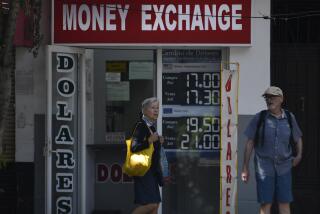Soaring dollar puts the world on sale for Americans

<p>Markets expert Tom Petruno says the strong dollar puts the world on sale for American travelers.</p>
- Share via
Americans have long complained that the dollar doesn’t buy much anymore. Suddenly, the dollar’s problem may be that it buys too much — a change that has huge implications across the global economy for consumers, businesses, investors and governments.
The U.S. currency’s value has surged over the last nine months, reaching levels against some world currencies last seen more than a decade ago. In Europe, it now costs just $1.09 to buy one euro, down from $1.37 a year ago and almost $1.50 four years ago.
To put it another way, an American tourist strolling the streets of Paris this April can buy 25% more croissants, cafe au laits or mini Eiffel towers than a year ago with the same dollars.
The greenback’s advance has been even more dramatic against some rivals. With its latest rally, one buck buys 30% more Swedish kronor than a year ago, 40% more Brazilian reais and 61% more Russian rubles.
The breadth of the rally has taken Wall Street by surprise. The dollar “has gained ground against every single major currency and most emerging-market currencies,” said Camilla Sutton, a foreign-exchange strategist at Scotiabank in Toronto.
The basic explanation for the return of the almighty dollar is that the U.S. economy is in better shape than most of the rest of the world, attracting investment and thereby raising demand for dollars. A standard assumption of capitalism is that money will go where it’s treated best — the strongest economic growth, say, or the most attractive interest rates.
But the rapid devaluation of other currencies against the dollar is being abetted by foreign governments and their central banks.
In a global economy struggling to grow, a nation that lets its currency sink in value puts itself on sale. That, in turn, can help revive growth by slashing prices of the country’s exports and by making its stocks, real estate and other assets relative bargains for foreign investors.
“Countries are fighting for market share,” said Richard Bernstein, head of money management firm Richard Bernstein Advisors in New York. “How do you get it? You make your currency cheaper.”
The danger is that this could become a downward spiral, with each country trying to out-devalue the others. Some experts fear that the devaluation wave could lead to a new financial crisis.
And for devaluation to work as countries hope depends in large part on America playing along as lone strongman — putting U.S. companies at what could become a serious economic disadvantage.
For now, the effects of the dollar’s big rally are showing up quickly in the real economy. Here’s a look at winners and losers among consumers, businesses, investors and governments:
Consumers
For Americans, the planet is on sale. In most of the world, the dollar buys significantly more than it did a year ago.
Western Europe gets a lot of the publicity because the euro is the weakest it has been since 2003. But the dollar is up 22% from a year ago in Poland, 20% in Morocco, 14% in Mexico and 12% in South Africa.
That is causing vacation plans to be rethought. “People are saying, ‘Maybe we should look at Europe again,’ where in the past they had ruled it out,” said Wido Schaefer, head of the TravelStore travel agency, which has 10 locations in California.
Also, tourists are choosing higher-quality foreign hotels because it takes fewer dollars to trade up, he said.
For 30-year-old Adrian Uribarri, a New York media consultant, a vacation in Morocco this month brought home the benefits of the dollar’s surge.
“We read that haggling is a national sport here. So the strong dollar made us feel like we were playing with an advantage,” he said from Marrakesh. “We knew that even if we settled on a higher price, we’d still come out with a bargain.”
With the dollar rising, Americans logged a record 68.3 million trips abroad last year, according to the International Trade Assn. Mexico accounted for the lion’s share of U.S. trips, at 25.4 million. Canada was second at 12.1 million, followed by Europe as a whole at 11.9 million.
The flip side of a strong dollar is that the cost of visiting America has risen. That could hurt California, which ranks second only to New York as a destination for foreign visitors.
The Los Angeles Tourism and Convention Board estimates that a record 6.5 million foreigners visited L.A. County last year.
One advantage for the L.A. area: The largest share of visitors — about 686,000 — came from China. And because China has mostly kept its currency steady against the dollar for the last two years, its tourists haven’t suffered a loss of purchasing power.
For many Americans the effects of the strong dollar will show up in prices they pay for imports. As the dollar rises, foreign companies gain a competitive edge. They can choose to reduce prices of what they sell in America without hurting their profit because each dollar in sales translates into more foreign currency.
The U.S. imported a record $2.85 trillion of goods and services last year. Overall, import prices were down 5.5% for the year, though most of it stemmed from the plunge in oil prices, according to government data.
However, an index of import prices excluding fuel also has fallen in recent months and in February hit its lowest level in four years, as prices fell on foreign cars and machinery. By contrast, that index had risen 20% from 2002 through 2012.
Businesses
Here’s the toll that the rising dollar is taking on U.S. companies, courtesy of a survey last month by Duke University and CFO Magazine: Of companies that get at least 25% of their total sales overseas, two-thirds said the dollar’s surge was hurting them. Almost one-quarter of the firms said they planned to cut capital spending to offset the hit to their businesses.
“U.S. exporters are being punished by these competitive depreciations, and this will lead to lower profits and less employment,” said Campbell Harvey, an economics professor at Duke’s Fuqua School of Business. “This stuff will come back to bite U.S. economic growth.”
Already, big-name companies, including Procter & Gamble, Tiffany & Co., Johnson & Johnson and Microsoft, have blamed the strong dollar for disappointing fourth-quarter financial results or for a weak 2015 forecast, or both.
After six straight years of profit growth for companies in the Standard & Poor’s 500 index, “the earnings train continues to strain,” advisory firm S&P Capital IQ warned last week. The firm estimates that overall S&P 500 operating earnings fell 3% in the first quarter from a year earlier, and will drop 2.1% in the current quarter.
A rising dollar can hurt U.S. companies in two ways. One is a long-term effect of having their competitiveness eroded if foreign rivals can undercut them on price.
The immediate effect, though, is one of simple currency translation: Sales and earnings made overseas automatically shrink when translated to dollars in quarterly financial statements.
But while foreign trade is a major issue for U.S. multinational companies, it is much less important to the U.S. economy as a whole. The total value of U.S. exports equals a modest 13% of the nation’s total economic output — compared with 26% in Turkey, 30% in Britain and 54% in South Korea.
Still, coupled with demands for higher wages to combat income inequality, “a strong dollar will mean new incentives to boost productivity growth at U.S. companies,” said Marc Chandler, currency strategist at Brown Bros. Harriman in New York.
That could slow the hiring wave that has helped slash unemployment since 2012.
Investors
Disappointing corporate earnings this year, blamed partly on the dollar, are threatening to derail the U.S. stock bull market that has generated huge returns for investors since March 2009.
Year to date, the Dow Jones industrial average is off 0.3%. The Standard & Poor’s 500 index is up just 0.4%.
Meanwhile, stocks in Europe have surged as the European Central Bank further devalued the euro by pushing long-term government bond yields to zero or even below. The Stoxx 600 index of European blue-chip shares is up 16% year to date.
But for U.S. investors in European shares, returns have been far smaller. That’s because the falling euro is a sort of hidden tax on foreigners, offsetting much of their gains. The average European stock mutual fund for American investors is up 5.3% year to date, about one-third of the Eurozone stocks’ advance.
That hidden tax has left the average emerging-markets stock fund for U.S. investors up a modest 2.1% this year.
All of this has complicated stock-picking for U.S. investors. Money manager Bernstein said he has been buying shares of Japanese and European exporters, while also using currency trading techniques to hedge against further devaluation.
Some U.S. investors are moving out of multinational stocks and into shares of smaller American companies that do little or no business overseas. That shift has helped lift the Russell 2000 small-stock index 4.2% this year.
The dollar’s strength also has been a friend to investors in U.S. bonds, keeping yields subdued this year. The benchmark 10-year Treasury note yield has fallen to 1.84% from 2.25% on Jan. 1.
Even though the Federal Reserve is widely expected to begin raising short-term interest rates in the second half of the year, the potential for the dollar’s surge to slow U.S. economic growth and drive down inflation gives the Fed leeway to be more patient.
“The dollar is definitely slowing them down,” said Ethan Harris, co-head of global economics at Bank of America Merrill Lynch.
Governments
Every government and central bank that fosters currency devaluation is taking a big gamble — one that gets bigger with each day.
The best-case scenario is that weak foreign currencies will boost the exports of struggling economies without hurting American companies enough to cause a new U.S. recession.
“A higher dollar effectively transfers demand from the U.S. economy to economies around the world,” said David Kelly, chief global strategist at J.P. Morgan Funds in New York. “In the long run, this should lead to a healthier, more balanced global economy.”
The danger is that devaluation could turn into a spiral driven by speculators who play in currencies for short-term gain. Global currencies make up the world’s single largest financial market, with trading volume each day of $5 trillion or more.
There are two big wild cards now in the devaluation game.
One is the risk of debt defaults by foreign governments and companies that have large dollar-denominated loans. If a borrower must repay in dollars and the borrower’s native currency is falling in value, it takes an increasing amount of local currency to repay the loan.
The total of dollar-denominated debt owed by non-bank borrowers outside the U.S. has jumped 50%, to $9 trillion, over the last six years, according to the Bank for International Settlements.
With devaluation, “the biggest chance for a financial market shock may lie outside of the United States,” said Jack Ablin, chief investment officer at BMO Private Bank.
The other wild card is China. The world’s biggest exporter so far has opted against devaluation, holding its currency steady against the dollar. China’s government has emphasized the need to show the world that it is ready to lead on economic issues.
But with its own growth slowing substantially, it isn’t clear whether China can ignore the siren’s call of devaluation, said C. Fred Bergsten, senior fellow at the Peterson Institute for International Economics in Washington.
“China is the huge question now.”
More to Read
Inside the business of entertainment
The Wide Shot brings you news, analysis and insights on everything from streaming wars to production — and what it all means for the future.
You may occasionally receive promotional content from the Los Angeles Times.










